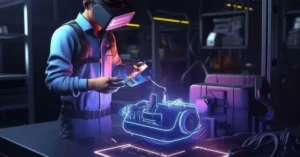An Interview with Micah Chaban, Founder and VP of Sales at RapidMade
Micah Chaban is the Founder and VP of Sales at RapidMade, a company at the forefront of advanced manufacturing and custom part solutions. Specializing in 3D printing, thermoforming, and machining, RapidMade has built a reputation for delivering high-quality components in record time. Under Micah’s leadership, the company continues to explore new frontiers in ESD (Electrostatic Discharge) materials, ensuring that sensitive electronics and high-precision assemblies remain protected.
For those unfamiliar with the term, can you explain what “ESD materials” are and why they matter in modern manufacturing?
ESD materials are engineered to safely dissipate static electricity, preventing sudden discharges that can damage electronic components or even ignite flammable substances. They’re particularly crucial in industries such as aerospace, automotive, and medical devices, where even a tiny spark can compromise expensive technology or set off an explosion.
How does RapidMade incorporate ESD materials into its range of services, like 3D printing, thermoforming, and machining?
We tailor each process to a client’s specific needs. For 3D printing, we use special ESD-safe filaments—often Nylon or ABS. We also have a proprietary in house coating. In thermoforming, we rely on materials like ESD-safe Royalite or coated polycarbonate sheets. When machining, we work with both metals and plastic stock already formulated for static-dissipative performance. Every choice balances lead time, cost, and functional requirements.
What are some of the most intriguing or challenging projects that RapidMade has worked on in using ESD plastics?
Our standard cases involved creating large thermoformed shipping and handling trays for circuit boards in sensitive aerospace applications and robotics applications. We have to ensure our in house coatings have a 100% success rate through extensive testing. Often these boards are 5 or 6 figures in cost – one failure is an enormous cost to the customer.
We have made ESD plastics for high flammability environments where a spark isn’t just a cost but could injure someone. Another involved lightweight, sterilizable 3D-printed enclosures for a medical-device startup, which required careful testing of the ESD properties and ensuring the coating did not affect cytotoxicity. Unfortunately we are under NDA for most projects and client data is sensitive so I cannot share the details.
How do you see advancements in additive manufacturing shaping the future of precision applications for electronics, aerospace, or medical industries?
Additive manufacturing removes many of the design constraints of traditional methods and accelerates prototyping. We’re now able to print complex geometries that dissipate static more effectively.
Emerging ESD-safe polymers—like carbon nanotube-infused plastics—promise both excellent conductivity and high mechanical strength, pushing innovation in electronics housings, aerospace brackets, and medical instruments. ESD resins themselves are very expensive. By providing ESD properties via a surface coating we are actually able to undercut the market.
Could you share a success story where RapidMade’s ESD expertise played a critical role in solving a client’s problem?
A technology firm approached us when their optical sensors were failing due to electrostatic discharges. By designing a custom ESD polycarbonate enclosure, formed through thermoforming, we eliminated their static-related issues. It was rewarding to see how the right material and manufacturing approach made such a significant difference.
In your experience, which industries benefit most from ESD-safe solutions, and how does RapidMade cater to those specific sectors?
Electronics manufacturers are the obvious beneficiaries, but aerospace and medical industries also demand ESD control for safety, reliability, and cleanliness. Optical customers need to control for static charges accumulating dust.
Electric vehicles, semiconductors and robotics also often do not want any insulators on their BOMs (bill of materials.) We serve each sector by collaborating closely with engineering teams, validating material performance, and refining designs at every stage of production.
What are some of the main misconceptions about manufacturing with ESD materials, and how do you address them with clients or partners?
Many assume ESD materials are prohibitively expensive. While their per-pound cost can be higher, they ultimately save money by preventing damage to critical components. Most customers assume they need to injection mold or machine expensive components to get the material properties they want – not true anymore.
Another misconception is that all ESD materials offer the same properties; in reality, different ranges of resistivity suit different applications. We guide clients to the best option for their unique needs.
How does RapidMade ensure quality control and consistency when working on complex ESD parts, especially for mission-critical applications?
We developed a proprietary in-house ESD coating process that ensures consistent coverage and performance across every batch we produce. In addition, we perform surface resistivity testing to confirm that parts maintain the promised electrical properties in the field.
Thanks to these rigorous measures, we’ve never had a single RMA for failed electrical properties in the eight years since we launched our first line of coated products. This track record speaks to our commitment to reliability, and it’s why clients trust us with mission-critical applications that demand stringent performance standards.
Could you discuss any collaborations or research initiatives that RapidMade is part of, which might expand the capabilities of ESD materials in the coming years?
We partner with raw material manufacturers around the globe to stay on the cutting edge of emerging ESD technologies, constantly experimenting with new formulations. In fact, we recently launched the world’s first thermoformable carbon fiber plastic, which leverages carbon’s inherent conductivity to provide natural ESD protection throughout the material. This innovation demonstrates our commitment to expanding what’s possible in static-safe manufacturing.
How do you see the balance between traditional manufacturing methods (like machining) and newer technologies (like advanced 3D printing) evolving over the next decade?
Machining remains the benchmark for tight tolerances and complex metals. However, 3D printing is constantly improving in speed, cost, and material capabilities. In practice, many projects benefit from a hybrid approach: 3D-printed prototypes and machining for final production. This balance ensures cost-effectiveness and efficiency.
We print thousands of these components every year—tens of thousands in total since we first introduced these part numbers. Our process is price-competitive with injection molding, but offers significant advantages: there’s no need for tooling or inventory, and customers can revise their designs at any time without incurring extra costs.
How can businesses interested in learning more about RapidMade’s capabilities or requesting a quote get in touch?
The simplest route is to visit rapidmade.com or email info@rapidmade.com. Our team is ready to discuss ESD materials, offer tailored manufacturing strategies, and help businesses bring their innovative ideas to life with static-safe components and reliable solutions.
If you find this article helpful, click here for more.









